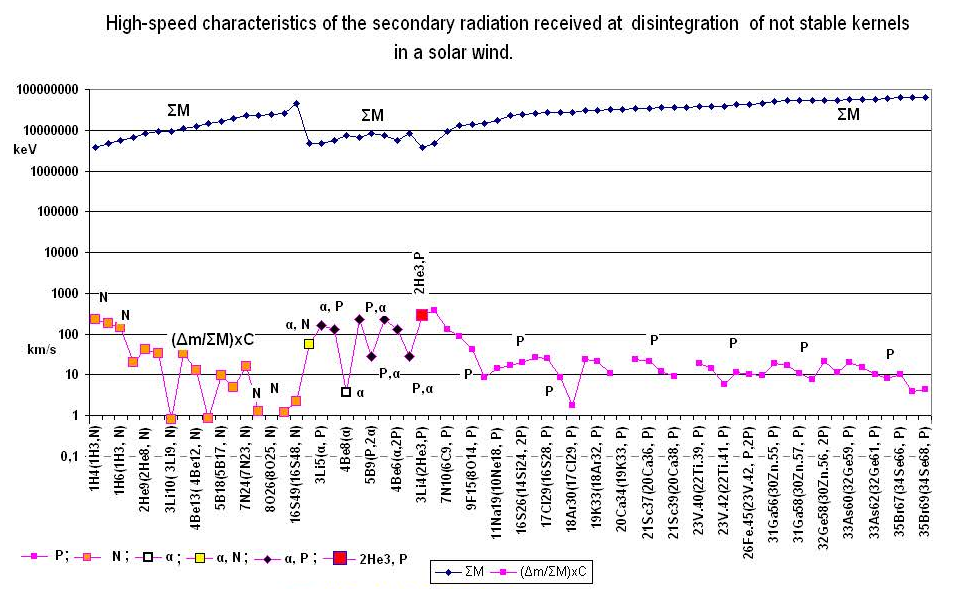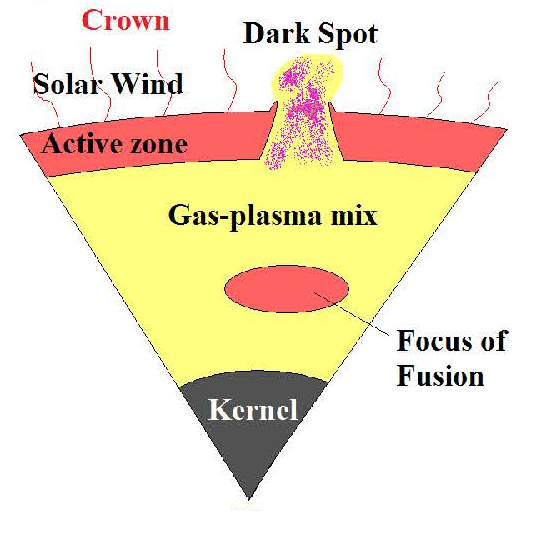For the simplification and presentation from table № T-4.4, the necessary data are written in table № T-4.4a. On the data basis in table № T-4.4a, schedules № G-4.3 and № G-4.3a are constructed.
(80) Table № T-4.4a.
High-speed characteristics of secondary radiation in a solar wind. v=(Δm/ ΣM) . C
(Extract from the TABLE № T-4.4)

(81) Schedule № G-4.3
The schedule № G-4.3 is made considering the weight increase of disintegration splinters (ΣM) — the top schedule, line — ΣM. The bottom schedule shows the high-speed characteristic of splinters, with the instruction of particles allocated at the disintegration period (P — a proton; N — a neutron; α — kernels of helium He with A=4; He3-kernels of helium He with A=3).
(82) Schedule № G-4.3a
The schedule № G-4.3a is made considering the particles allocated at disintegration. In the beginning of the bottom schedule we see the high-speed characteristics of splinters during the neutrons radiation, is designated by the letter — N. The middle part contains the high-speed characteristics of splinters at disintegration which, are allocating kernels of helium He with A=4 (α) and with A=3 (He3). Along with the helium kernels, protons and neutrons are being allocated. The area of the schedule where kernels of helium are allocated, are designated as «α, N» and «α, P». The third part of the high-speed characteristic, the area is designated by the letter «P», where the protons are allocated during the disintegration. From the constructed schedules № G-4.3, №G-4.3a it is visible, that neutrons, protons, kernels of helium can be a part of «the solar wind», both as a result of synthesis of kernels, and at the disintegration of synthesized kernels. The electrons speeds are above the speeds of isotopes, since the weight of electrons is less than these kernels weight. We have considered the formation of particles of «the solar wind» received as a result of unstable kernels disintegration, but there is a probability that after the synthesis of an unstable kernel, this kernel breaks up few times while moving in the structure of «the solar wind». In this case, the speed of kernels and particles change few times during the movement, as shown in figure № R-4.15.

(83) Figure № R-4.15
It is necessary to consider, that the high-speed characteristics of kernels and particles at disintegration do not consider the high-speed characteristics of the unstable kernels before their disintegration. At a more accurate calculation, it is necessary to consider the speed of unstable kernels received during the disintegration.
At the analysis of «the solar wind», it is necessary to consider and instability of the neutron which breaks up in 15 minutes. At the disintegration of neutron allocated a proton and an electron, which will have own speed spectra of in the structure of «the solar wind». The highest interest for researchers is presented in the movement of electronic stream, which can be easily transformed into magnetic, electric and even to x-ray signals. Considering, that the speed of electrons depends on the nuclear reactions in which they were born, it is probable that signals received from an electronic stream, can give us the information on nuclear reactions to star surfaces. In an early stage of life, a chemical compound of stars is consisted of easy atoms of hydrogen, during the synthesis of kernels of hydrogen in helium kernels; the maximum quantity of energy is allocated. At the allocation of maximum quantity of energy, the speed of the majority of particles and kernels in the solar wind is high (maximal). Hence, the volume of the heliosphere of a young star is maximal. During the life period, the chemical compound of the star changes, the quantity of heavy atoms increases, and the participation of kernels of these atoms in the synthesis does not give the maximal allocation of energy. Hence, the share of high-speed particles and kernels, as a part of the solar wind, decreases, the proportion of low-speed particles and nuclei are increases and the volume of a heliosphere of the star decreases.
The given analysis of «the solar wind» is based on the theory offered by us which allows explaining many experimentally obtained data. The picture of the Sun in neutron radiation receives its logic explanation. According to theory of Eddington about the Sun structure, and Parker theory about the solar wind, radiation of neutrons from the surface of a star should not exist, as well as some other radiations, probably. But from the position of our theory, in the process of synthesis of kernels in the top layers of the atmosphere of a star and at the further disintegration of unstable isotopes, there is radiation of neutrons, protons, kernels, x-ray and scale-beams. In the picture of the Sun in neutron radiation, in the central part, on the surface of a star and the areas adjoining to it, the intensity of radiation is high, since here there is the greatest concentration of unstable kernels radiating neutrons.
Distancing from the center, the quantity of unstable kernels decreases due to the expansion of the volume, hence, the density of neutrons radiation decreases, as it is visible in figure № R-4.2.
If we analyze pictures of the Sun made in different beams, it is possible to create a full picture of nuclear processes that are going in «the active zone» of stars. We will consider the facts confirming the existence of thermonuclear synthesis in the Sun upper atmosphere in the active zone (in the photosphere and the chromosphere).
— Presence of high-energy plasma in the stars upper atmosphere — in the active zone and in its crown, is the direct fact of the existence of thermonuclear synthesis in the active zone.
— High speed of particles of the solar wind is also a direct fact of the existence of thermonuclear synthesis in the active zone.
— The radiation scheme of neutrino of a star, being the map of centers of thermonuclear synthesis arrangement, is the direct fact of existence of thermonuclear synthesis in an active zone.
— The period of change in neutrino radiation in the star, coinciding with the period of rotation of the top layers of its atmosphere (27 days), confirms indirectly the existence of thermonuclear synthesis in the active zone.
— The presence of radioactive isotopes as part of the solar wind and in the stars heliosphere, is the direct fact of the existence of thermonuclear synthesis in the active zone.
— The presence of neutrons having high speed as components of the solar wind is the direct fact of the existence of thermonuclear synthesis in the active zone.
— The density of radiation of the solar wind at the level of the orbit of the Earth makes N = 15 particles in square centimeter. With the help of simple calculations we will define the density of radiation of the solar wind on distance of 1000 km from the Sun surface.
The radius of the point removed from the Sun surface on distance of 1000 km, makes Rs= 697000 km, radius of Earth orbit of Rz= 1а.u. = 149600000 km.
The density of radiation of the solar wind at the Sun surface will be calculated by the formula:
Ns=N . (Sz/Ss) = N . (Rz2/Rs2) = 691017 particles/sm2
Where: Ss — the area of the sphere surface with radius Rs;
Sz— The area of the sphere surface with radius Rz.
The density of radiation of the solar wind, on distance of 1000 km from the Sun surface, makes 691017 particles/sm2 is commensurable with radiation density at nuclear explosions. The given calculation confirms indirectly the fact of synthesis of nuclear kernels in the Sun upper atmosphere.
We have listed seven direct and indirect facts, confirming the existence of thermonuclear synthesis in the active zone (in the Sun upper atmosphere). That contradicts the theory of Eddington which claims that the thermonuclear synthesis of kernels of helium from hydrogen kernels occurs only in a star kernel.
— CONCLUSIONS:
We have analyzed the data of «the solar wind». Based on this analysis, it is possible to draw the following conclusions:
1. The synthesis of easy kernels with the allocation of most of the energy occurs in the top layers of the Sun and stars atmospheres (in photosphere, chromosphere).
2. Kernels and particles in «a solar wind» receive high speed, as the result of nuclear reactions of synthesis and disintegration in both the active zone of the star and beyond its limits.
3. The heavy and super heavy kernels of atoms received as a result of synthesis of easy kernels, are being accumulated in the kernel of a star, forming «the white dwarf».
4. The star structure includes (figure № R-4.13):
— A kernel which in the beginning of life consists of the compressed fuel or easy atoms, during life heavy atoms are collected in the center of the kernel, superseding the easy ones and forming, «the white dwarf». In the end of life of a star, the kernel probably, is consisted of «slags» which have accumulated in the center, forming «the white dwarf», and the compressed fuel, as a result of thermonuclear synthesis which passed into a gas-plasma mix, has partially turned to slag, and partially is thrown out into space.
— The gas-plasma mix, surrounds the kernel of star and represents a mix of gas and plasma. Heating of the gas-plasma mix occurs from the top layers of the star atmosphere and from the internal areas, where there is a thermonuclear synthesis with allocation of energy, and is possible, from the centers of division of heavy kernels.
— An active zone — the top layers of the atmosphere of a star where there is an allocation of most of the energy — photosphere, chromosphere and the bottom layers of the crown.
— The crown represents: stream of particles, atoms, kernels of atoms, isotopes, radiations, a full spectrum of the electromagnetic radiations, having high density. In the crown there are nuclear reactions with allocation of energy. The basis of these reactions is made with disintegration of unstable kernels of atoms, which have been synthesized in stars «the active zone». Nuclear reactions of synthesis are possible in the bottom layers of the crown. The luminescence of the crown speaks, probably, in favor of two factors:
— High density of radiations from «the active zone»;
— There are nuclear reactions of disintegration in the crown, probably, and a synthesis with allocation of energy.
(84) Figure № R-4.13




